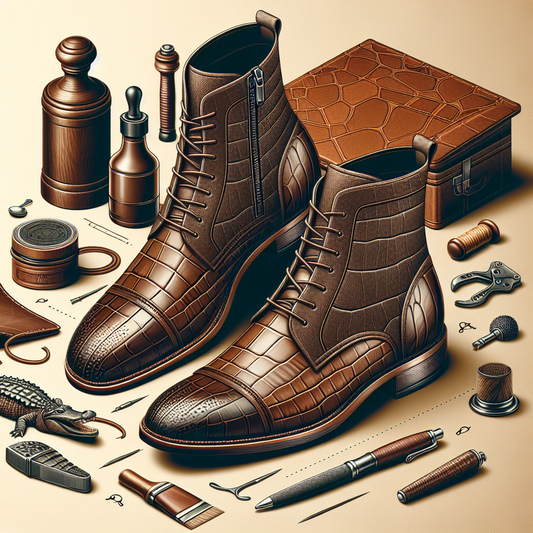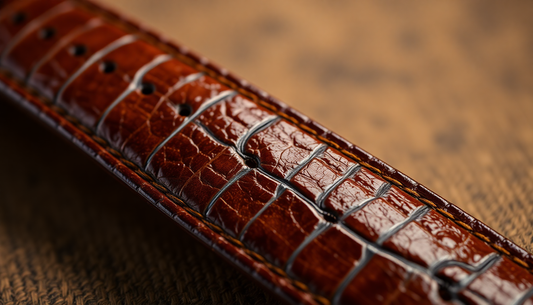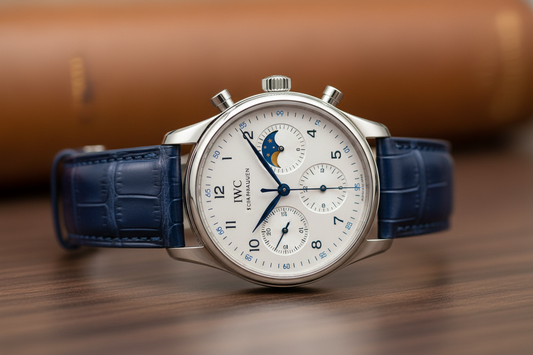How to Change a Leather Watch Strap: A Comprehensive Guide for Style and Durability
How to Change a Leather Watch Strap: A Comprehensive Guide for Style and Durability
A watch is more than just a timekeeping device; it's a statement of personal style. And what better way to express that style than with a sleek and durable leather watch strap? Whether you're looking to switch up your look for a special occasion, replace a worn-out strap, or simply want to experiment with different styles, knowing how to change a leather watch strap is a valuable skill. It's a simple process that allows you to personalize your watch and breathe new life into your timepiece. In this comprehensive guide, we'll walk you through the process step-by-step, covering everything from choosing the right strap to installing it with confidence.
The Allure of Leather Watch Straps
Leather watch straps have long been a favorite choice for watch enthusiasts, and for good reason. They offer a combination of elegance, comfort, and durability that's hard to beat. Here's why genuine leather watch bands are so popular:
- Classic Elegance: Leather exudes a timeless charm that complements any watch style, from dressy to casual. It adds a touch of sophistication and elevates the overall look of your watch. The natural texture and subtle sheen of leather create a sophisticated aesthetic that complements both formal and informal attire.
- Exceptional Comfort: Leather conforms to the shape of your wrist, providing a comfortable and secure fit. It's breathable, allowing your skin to breathe even during extended wear. Unlike rigid metal straps, leather allows for natural airflow, preventing discomfort and perspiration buildup. This makes leather straps ideal for all-day wear, whether you're at work, at a social event, or engaging in casual activities.
- Durable and Long-Lasting: Quality leather straps are designed to withstand the test of time. They're resistant to wear and tear, making them a wise investment for any watch owner. With proper care, a high-quality leather strap can last for years, providing consistent comfort and style. Unlike synthetic materials that can easily crack or deteriorate, genuine leather ages gracefully, developing a unique patina that adds to its character over time.
- Versatility: Leather straps come in a vast array of colors, textures, and finishes, allowing you to customize your watch to match your outfit, mood, or occasion. From smooth and polished to rugged and distressed, there's a leather strap to suit every taste. You can choose a classic black or brown strap for everyday wear, a vibrant color to add a pop to your outfit, or a textured strap for a more adventurous look. The wide range of options ensures that there's a leather strap that perfectly complements your individual style and preferences.
Choosing the Perfect Leather Watch Strap
With so many options available, selecting the right leather watch strap can seem overwhelming. Consider these key factors to make an informed choice:
1. Strap Material:
- Genuine Leather: This is the most common and desirable material for watch straps. It's naturally breathable, comfortable, and ages beautifully with time. Look for straps made from high-quality leather like calfskin, cowhide, or alligator leather, each with its unique characteristics and level of durability. Calfskin is known for its softness and suppleness, making it ideal for everyday wear. Cowhide is a more durable option, often used for rugged and casual straps. Alligator leather is the most luxurious and expensive choice, prized for its unique pattern and luxurious feel.
- Synthetic Leather: A more affordable alternative to genuine leather, synthetic leather offers similar aesthetics but lacks the breathability and longevity of genuine leather. However, it's a good option if you're on a budget or looking for a waterproof strap. Synthetic leather is often made from polyurethane or PVC, which can be more resistant to water and moisture than genuine leather.
2. Strap Size:
The width of your watch strap is crucial for a proper fit and appearance. Measure the width of your existing strap at the lugs (the points where the strap attaches to the watch case). This measurement will ensure you choose a compatible replacement strap. Most watch straps come in standard sizes like 18mm, 20mm, 22mm, or 24mm. It's important to choose the correct size for your watch, as a strap that's too narrow or too wide will look awkward and may not fit securely.
3. Strap Type:
Leather watch straps are available in various styles, each with its unique characteristics and look. Here are some common types:
- Buckle Straps: The most traditional and versatile type, buckle straps feature a simple buckle closure that adjusts to your wrist size. They come in a variety of buckle styles, from classic pin buckles to more modern tang buckles. Buckle straps are a great choice for everyday wear, as they're comfortable, secure, and easy to adjust.
- Deployment Straps: These straps feature a folding clasp that secures with a push button. They are more secure and convenient than buckle straps, especially for larger watches. Deployment straps are typically found on more expensive watches, as they offer a more sophisticated and refined look. They're also easier to use than buckle straps, as you don't need to fiddle with the buckle to secure the strap.
- NATO Straps: Originally designed for military use, NATO straps are nylon straps with a unique loop system that provides extra security. They're known for their durability and affordability. NATO straps are a great choice for active individuals who need a strap that can withstand wear and tear. They're also available in a wide range of colors, making them a versatile option for any outfit.
- Perlon Straps: These straps are made from a type of nylon fabric that's soft and comfortable to wear. Perlon straps are known for their durability and quick-drying properties, making them a great choice for swimming or other water activities. They're also a popular choice for vintage watches, as they have a classic look and feel.
Tools You'll Need for a Successful Strap Change
Before you embark on changing your watch strap, gather the necessary tools to ensure a smooth and hassle-free process. These tools are readily available online or at watch repair shops:
- Small Screwdriver: Most watch straps utilize spring bars to connect to the lugs. A small, flat-head screwdriver is needed to remove and replace these bars. Choose a screwdriver that fits the size of the spring bars on your watch. It's essential to have a screwdriver that's the right size to avoid damaging the spring bars or your watch.
- Spring Bar Tool: This specialized tool is a must-have for anyone changing watch straps. It provides leverage and precision when removing and inserting spring bars, minimizing the risk of damaging the strap or your watch. There are various types of spring bar tools available, including handheld tools and pliers. Choose a tool that feels comfortable and provides a secure grip.
- New Leather Watch Strap: Choose your preferred material, size, and style. Ensure it's compatible with your watch and matches your personal taste. It's a good idea to have your new strap ready before you start the process to avoid delays and ensure a smooth transition.
Step-by-Step Guide to Changing Your Leather Watch Strap
Now that you have the right tools and a new strap ready, let's dive into the process of changing your leather watch strap. Follow these steps carefully:
1. Remove the Old Strap
- Locate the spring bars: These small metal pins are positioned at the ends of the strap where it connects to the lugs. Look for them carefully; they are often hidden under the strap. If you can't find the spring bars, you can use a magnifying glass or a small flashlight to help you locate them.
- Position the spring bar tool: Place the tool's prongs between the spring bar and the lug, ensuring it's properly aligned. This step requires a steady hand and gentle pressure. Avoid using excessive force, as it could damage your watch or the strap. The prongs of the spring bar tool should be positioned on either side of the spring bar, pressing against the lug and the spring bar itself.
- Gently push the spring bar out: Use the spring bar tool to push the spring bar out from the lug. Apply even pressure and move the tool in a smooth, rocking motion until the spring bar releases. The strap should detach once the spring bar is completely out. If the spring bar is stubborn, you can try using a little lubricant, like silicone spray, to help it slide out more easily.
- Repeat for the other side: Follow the same steps to remove the spring bar on the opposite side of the strap. Once both spring bars are removed, the strap should come off the watch easily.
2. Install the New Strap
- Position the new strap: Align the new leather strap with the lugs, making sure it's centered and securely fitted. Ensure the strap is properly positioned with the lugs before proceeding to the next step. If the strap isn't aligned correctly, it could put unnecessary stress on the spring bars, leading to damage or premature wear.
- Insert the spring bars: Use the spring bar tool to gently push the spring bars back into the lugs. Insert the spring bar from the outside of the lug, pressing it in until it clicks securely into place. Repeat the process on the other side. Be careful not to force the spring bars in; they should slide in with gentle pressure. If the spring bar doesn't want to go in, make sure it's properly aligned with the lug and that you're applying even pressure. If necessary, you can use a small piece of tape to hold the spring bar in place while you insert it into the lug.
- Adjust the strap length: Once the new strap is attached, adjust the buckle to fit your wrist comfortably. Secure the buckle and double-check that the strap is secure. You're now ready to rock your new leather strap. It's a good idea to try on the watch and move your wrist around to make sure the strap is secure and comfortable. You can also adjust the buckle to your preferred tightness.
Tips and Precautions for a Smooth Strap Change
Changing a watch strap is a relatively simple process, but here are some tips and precautions to ensure a successful and safe experience:
- Work on a clean surface: Choose a clean, flat surface to prevent dust and debris from getting into your watch or the new strap. A clean workspace will help you avoid any scratches or damage to your watch or the strap. You can use a soft cloth to wipe down the surface before you begin.
- Be gentle: As mentioned earlier, avoid using excessive force when removing or installing spring bars. Gentle pressure and steady hands will prevent damage to your watch or the strap. If you're struggling to remove or install a spring bar, it's better to stop and try again later, or seek help from a professional.
- Consider professional help: If you're not comfortable with the process or have a vintage watch with delicate components, it's best to seek professional assistance from a reputable watch repair shop. They have the expertise and tools to ensure a safe and accurate strap change. Watch repair shops are equipped with specialized tools and have the experience to handle delicate watches without causing damage.
- Clean the strap regularly: Leather straps tend to accumulate dirt, sweat, and oils over time. Clean them regularly with a soft cloth dampened with a mild leather cleaner to maintain their appearance and extend their lifespan. Leather cleaner will help to remove dirt and grime, while conditioning the leather will keep it supple and prevent it from drying out. Avoid using harsh chemicals or detergents, as these can damage the leather.
- Store your straps properly: When not in use, store your leather watch straps in a cool, dry place away from direct sunlight. This helps to prevent fading and damage. You can use a watch strap box or a zippered bag to store your straps. Avoid storing them in damp or humid environments, as this can lead to mold growth and damage.
Changing your leather watch strap is a rewarding experience. It allows you to personalize your watch, experiment with different styles, and express your unique taste. With a little practice and the right tools, you'll become an expert in switching up your watch straps, keeping your timepiece looking fresh and stylish for years to come. So, embrace the world of leather watch straps and discover the endless possibilities they offer. Whether you're looking for a classic leather strap, a modern deployment strap, or a rugged NATO strap, there's a perfect leather watch strap out there to complement your style and personality.








